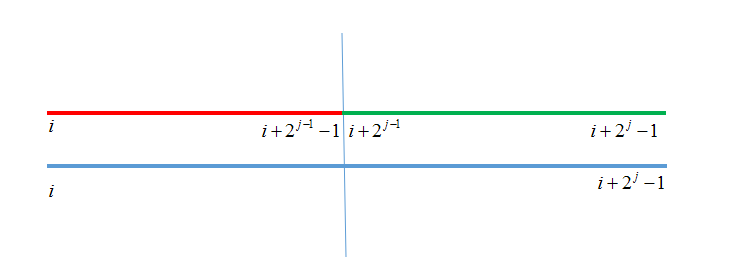我们在退役前再学一遍ST表23333:
首先,ST表,我们要知道它是干什么用的:它是用来求RMQ(区间最值)问题的。但是它最好是求静态(不修改)的区间最值,而别是求动态的,如果是动态的,那就需要用线段树来做了。(动态的ST会感觉很膈应。。。详见https://www.tuicool.com/articles/Ere2qyy)
首先先来讲一下静态的做法(ST表):在这里说一说ST表其实应该叫做ST,全名为SparseTable,即稀疏表,它一般是用来求静态RMQ问题的,它的预处理时间复杂度为O(nlogn)的,查询则是O(1)的,我们先以区间最大值来说。
其实也很简单,ST就是利用倍增的思想,每一个区间都可以被分割为两个小区间,直至到单个点(即为MAX[i][0]中存储的数)。我们可以设Max[i][j]为以i为起点,长度为2^j的区间中的最大值,所以它可以一段一段的被处理,就可以了。

而有人会问了,你又不是能保证【L,R】的区间长度一定是二的倍数,是滴,但是我们先可以求出两段区间的长度为2^k并使这个长度为仅小于r-l+1的2的倍数,即为k=log2(r-l+1),因为C++中的除法一般都是下取整的(起码这个是),所以就如下图啦:
从l到l+2^k-1这段区间和从r-2^k+1到r这两段是一定可以把这个区间都覆盖掉的(嗯!就是这样!喵!)。

还有要注意的是maxn的第二维开到25就够了,因为2^25为33554432,再开反正也过不了了,那就别开了,并且我们可以把maxn[100500][25]改成maxn[25][100500],因为ZAY说过这样会快的!并且这样的话就不用像我下面那样这么膈应的循环了。这样我们就可以成功的预处理出来啦!
1 #include<cstdio> 2 #include<iostream> 3 #include<algorithm> 4 #include<cmath> 5 using namespace std; 6 int maxn[100500][25],m,n,l,r; 7 int emm(int a,int b){ 8 int len=log2(b-a+1); 9 return max(maxn[a][len],maxn[b-(1<<len)+1][len]); 10 } 11 int main(){ 12 scanf("%d%d",&n,&m); 13 for(int i=1;i<=n;i++) 14 scanf("%d",&maxn[i][0]); 15 for(int i=1;i<=21;i++){//len 16 for(int j=1;j+(1<<i)-1<=n;j++){ 17 maxn[j][i]=max(maxn[j][i-1],maxn[j+(1<<(i-1))][i-1]); 18 } 19 } 20 for(int i=1;i<=m;i++){ 21 scanf("%d%d",&l,&r); 22 printf("%d\n",emm(l,r)); 23 } 24 return 0; 25 }
至于线段树的动态做法,我还是直接弄段代码吧,累死我惹,233。。。。见下:
1 #include<iostream> 2 3 using namespace std; 4 5 #define MAXN 100 6 #define MAXIND 256 //线段树节点个数 7 8 //构建线段树,目的:得到M数组. 9 void initialize(int node, int b, int e, int M[], int A[]) 10 { 11 if (b == e) 12 M[node] = b; //只有一个元素,只有一个下标 13 else 14 { 15 //递归实现左孩子和右孩子 16 initialize(2 * node, b, (b + e) / 2, M, A); 17 initialize(2 * node + 1, (b + e) / 2 + 1, e, M, A); 18 //search for the minimum value in the first and 19 //second half of the interval 20 if (A[M[2 * node]] <= A[M[2 * node + 1]]) 21 M[node] = M[2 * node]; 22 else 23 M[node] = M[2 * node + 1]; 24 } 25 } 26 27 //找出区间 [i, j] 上的最小值的索引 28 int query(int node, int b, int e, int M[], int A[], int i, int j) 29 { 30 int p1, p2; 31 32 33 //查询区间和要求的区间没有交集 34 if (i > e || j < b) 35 return -1; 36 37 //if the current interval is included in 38 //the query interval return M[node] 39 if (b >= i && e <= j) 40 return M[node]; 41 42 //compute the minimum position in the 43 //left and right part of the interval 44 p1 = query(2 * node, b, (b + e) / 2, M, A, i, j); 45 p2 = query(2 * node + 1, (b + e) / 2 + 1, e, M, A, i, j); 46 47 //return the position where the overall 48 //minimum is 49 if (p1 == -1) 50 return M[node] = p2; 51 if (p2 == -1) 52 return M[node] = p1; 53 if (A[p1] <= A[p2]) 54 return M[node] = p1; 55 return M[node] = p2; 56 57 } 58 59 60 int main() 61 { 62 int M[MAXIND]; //下标1起才有意义,保存下标编号节点对应区间最小值的下标. 63 memset(M,-1,sizeof(M)); 64 int a[]={3,1,5,7,2,9,0,3,4,5}; 65 initialize(1, 0, sizeof(a)/sizeof(a[0])-1, M, a); 66 cout<<query(1, 0, sizeof(a)/sizeof(a[0])-1, M, a, 0, 5)<<endl; 67 return 0; 68 }
资料参考来源(http://www.cnblogs.com/zwfymqz/p/8581995.html,https://www.cnblogs.com/ECJTUACM-873284962/p/6613342.html)